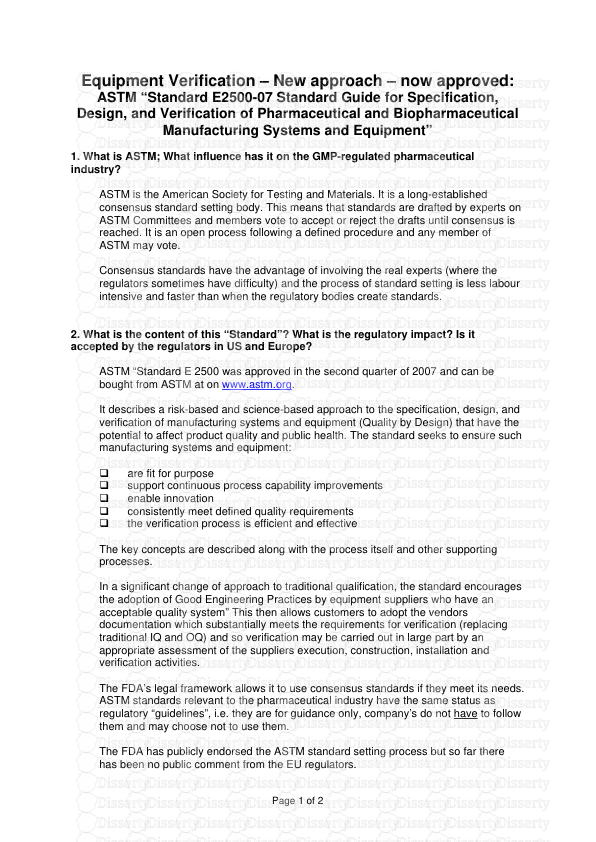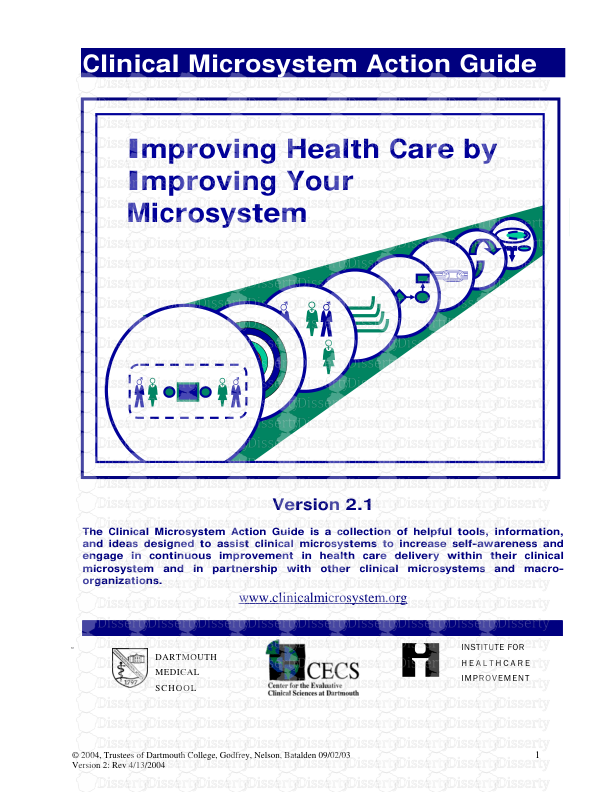© 2004, Trustees of Dartmouth College, Godfrey, Nelson, Batalden 09/02/03 1 Ver
© 2004, Trustees of Dartmouth College, Godfrey, Nelson, Batalden 09/02/03 1 Version 2: Rev 4/13/2004 Clinical Microsystem Action Guide Improving Health Care by Improving Your Microsystem Version 2.1 The Clinical Microsystem Action Guide is a collection of helpful tools, information, and ideas designed to assist clinical microsystems to increase self-awareness and engage in continuous improvement in health care delivery within their clinical microsystem and in partnership with other clinical microsystems and macro- organizations. www.clinicalmicrosystem.org INSTITUTE FOR H E A L T H C A R E IMPROVEMENT DARTMOUTH MEDICAL SCHOOL © 2004, Trustees of Dartmouth College, Godfrey, Nelson, Batalden 09/02/03 2 Version 2: Rev 4/13/2004 Table of Contents Preface and acknowledgements Welcome - Clinical Microsystem Background 5 • Institute of Medicine 6 • Self-Awareness Journey 7 • The Lenses of a Microsystem 8 • Science-Based Improvement 9 I. Assessing Your Practice Workbook “The Green Book” 10 II. Assess Your Clinical Microsystem 16 III. Start to Build Your Own Clinical Microsystem Diagram 20 IV. The Core Processes of Clinical Microsystems 24 A. Patient Entry/Access/Assignment B. Orientation C. Initial Work up/Assessment D. Plan of Care E. C.A.R.E. Vital Signs V. Patient Subpopulations: Planning Patient-centered Care 40 A. Acute/Emergent B. Chronic C. Preventive D. Palliative VI. Customer Knowledge 59 A. Gaining Customer Knowledge Worksheet, Interview Survey VII. Measurement and Monitoring 70 A. Feed forward and Feedback B. Balanced Scorecard/Instrument Panels C. Clinical Value Compass VIII. Linking Microsystems 82 IX. Special Themes: A. Safety 89 B. External Environment 101 C. Health Professional Education 102 X. Improving Your Clinical Microsystem 103 A. The basics B. Continuous improvement tools/forms/knowledge C. Storyboards XI. Want to Learn More? 150 XII. References and articles 153 XIII. Appendix 155 Table of Tools and Forms © 2004, Trustees of Dartmouth College, Godfrey, Nelson, Batalden 09/02/03 3 Version 2: Rev 4/13/2004 Preface and Acknowledgements Our years of experience in exploring, inquiring, and testing improvement ideas through the Center for the Evaluative Clinical Sciences at Dartmouth Medical School, the Dartmouth-Hitchcock system, Institute for Healthcare Improvement, and health care systems throughout the United States, England, Sweden, and Norway have provided the background of this Clinical Microsystem Action Guide. The people in the clinical microsystem who usually work together with technology support have been generous in their interest and energies to learn with us the tools and helpful information that will increase self-awareness to lead to action plans to improve their clinical microsystem. New knowledge and insights have been added based on this focused research. We are appreciative of the clinical microsystems throughout the US and around the world including England, France, Kosovo, Norway, and Sweden that have tested and given us feedback on the materials presented in Version 1.0 of the Clinical Microsystem Action Guide. Based on our field testing and continued development of microsystem knowledge, we offer Version 2.1. This work will continue to evolve over time as the knowledge of clinical microsystems grows, and as more and more health care systems engage in the discovery of clinical microsystems, success characteristics, and test tools and actions that can be taken to improve the health care delivery system, the workforce environment, and patient care outcomes. We are grateful for the support provided by the Robert Wood Johnson Foundation for RWJF Grant Number: 036103 that have furthered our experience and knowledge. We would also wish to express our gratitude and appreciation for the support of the high performing clinical microsystem sites in this study that hosted our visits and shared their stories: Bon Secours Wound Care Team Center for Orthopedic Oncology and Musculoskeletal Research (Washington Cancer Institute) Dartmouth-Hitchcock Spine Center Gentiva Rehab Without Walls Grace Hill Community Health Center Henry Ford Neonatal Intensive Care Unit Hospice of North Iowa Interim Pediatrics Intermountain Orthopedic Specialty Practice Intermountain Shock/Trauma/Respiratory Intensive Care Unit Iowa Veterans’ Home, M4C Team Luther Midelfort Behavioral Health Massachusetts General Hospital Downtown Associates Primary Care Norumbega Evergreen Woods Office On Lok Senior Health Rose Team Overlook Emergency Department Sharp Diabetes Self Management Training Center Shouldice Hospital ThedaCare Kimberly Office Family Medicine Visiting Nursing Service Congregate Care Queens Team 11S Whittier Institute for Diabetes Special Thanks We would like to express our sincere appreciation to: James Brian Quinn, PhD, MBA William and Josephine Buchanan Professor of Management, Emeritus, Tuck School of Business at Dartmouth College for his advice, counsel and continued encouragement of our work. Donald W. Berwick, MD, MPP President and CEO, Institute for Healthcare Improvement for his vision, tireless leadership, and collaboration to improve health care around the world. Thomas Nolan, PhD Statistician, Associates in Process Improvement and Co-Director of Pursuing Perfection and Senior Fellow at the Institute for Healthcare Improvement for his leadership and energy in the pursuit of excellence in health care. © 2004, Trustees of Dartmouth College, Godfrey, Nelson, Batalden 09/02/03 4 Version 2: Rev 4/13/2004 We also would like to acknowledge and express gratitude to our colleagues and friends at: ¾ Institute for Healthcare Improvement, 375 Longwood Avenue, 4th Floor, Boston, MA 02215 ¾ Hundreds of national and international sites and organizations we have collaborated and learned with over the years as we’ve furthered our knowledge of microsystems in health care improvement. It is their willingness to test and adapt ideas and tools and share their experiences that has advanced our knowledge. Special Acknowledgement: We would like to express our sincere thanks and appreciation for the tireless efforts, and past and current work experiences of the numerous leaders and clinical teams of the Dartmouth-Hitchcock System, hundreds of graduate/PhD students at the Center for the Evaluative Clinical Sciences at Dartmouth, Evaluative Clinical Sciences 124 course participants at Dartmouth Medical School and the practices they worked with, University of California, Davis Health System, Geisinger Health System, Goran Henriks, Jonkoping County Council, Sweden, and Sir John Oldham, GP, Head of the National Primary Care Development Team, United Kingdom. Clinical Microsystem Action Guide Team Editor: Marjorie M. Godfrey, MS, RN, Director of Clinical Practice Improvement for Dartmouth- Hitchcock Medical Center, Instructor for Community and Family Medicine at Dartmouth Medical School and Technical Advisor to Idealized Design of Clinical Office Practices at the Institute for Healthcare Improvement. Team: Marjorie M. Godfrey, MS, RN Eugene C. Nelson, DSc, MPH, Professor of Community and Family Medicine at Dartmouth Medical School, Director of Quality Education Measurement and Research at Dartmouth-Hitchcock Medical Center, and Senior Advisor for the Idealized Design of Clinical Office Practices and Pursuing Perfection Program and past Board member at the Institute for Healthcare Improvement. Paul B. Batalden, MD, Director of Health Care Improvement Leadership, Center for Evaluative Clinical Sciences, and Professor of Pediatrics and of Community and Family Medicine at the Dartmouth Medical School and Senior Vice President for Health Professional Development, founding Chair and current member of the Board of Directors at the Institute for Healthcare Improvement. John H. Wasson, MD, Hermon O. West Professor of Geriatrics at Dartmouth Medical School and Medical Director of Idealized Design of Clinical Office Practices at the Institute for Healthcare Improvement. Julie J. Mohr, MSPH, PhD, Assistant Professor in the Department of Medicine at the University of Chicago Thomas Huber, MS, Project Manager for The Robert Wood Johnson Foundation Grant for Health Care Improvement Leadership Development at Dartmouth Medical School 2000- 2002 Linda Headrick, MD, MS, Senior Associate Dean for Education & Faculty Development for the School of Medicine, University of Missouri-Columbia Graphic Coua L. Early, Administrative Coordinator, Dartmouth-Hitchcock Medical Design/ Center, 1998-2003 Layout Melissa D. DeHaai, Administrative Coordinator, Dartmouth-Hitchcock Medical Center, 2003-Current © 2004, Trustees of Dartmouth College, Godfrey, Nelson, Batalden 09/02/03 5 Version 2: Rev 4/13/2004 Welcome and Clinical Microsystem Background J. Brian Quinn, Professor Emeritus at the Amos Tuck School of Business Administration at Dartmouth College, spent several years studying successful service enterprises. He observed that successful enterprises progressively learned to focus on the smallest replicable unit (SRU). Quinn’s theory suggests that all organizations are comprised of small units that function to connect the core “competence” of the enterprise to the beneficiaries of that enterprise. We have adapted this idea for use in health care. His book Intelligent Enterprise describes his findings of highly successful service organizations. He reports that the leading service organizations organized around and continually engineered the frontline interface relationship that connected the organizations core competency with the needs of the individual customers. This frontline interface is referred to as the “smallest replicable unit.”1 We have translated the “smallest replicable unit” concept to health care – calling these units clinical microsystems. We will focus on the clinical microsystem in health care; a population of patients, providers and their support staff, core and supporting processes of care, information and information technology with a common purpose or aim. Microsystems provide a framework to organize, measure, and improve the delivery of care. We have used a variety of terms to describe this phenomenon, as we have become increasingly clear about this: panel management process, patient care pods, smallest replicable units, minimum replicable units, firms, micro-units, and now we refer to them as clinical microsystems. As we have used these terms we have tried to uploads/Geographie/ clinical-microassessment-guide.pdf
Documents similaires








-
34
-
0
-
0
Licence et utilisation
Gratuit pour un usage personnel Attribution requise- Détails
- Publié le Aoû 31, 2021
- Catégorie Geography / Geogra...
- Langue French
- Taille du fichier 4.5722MB


